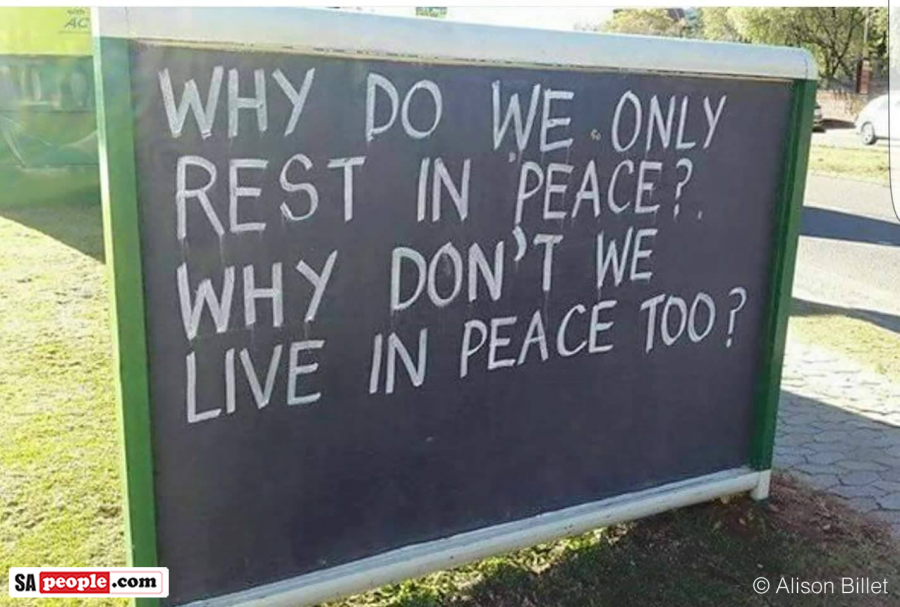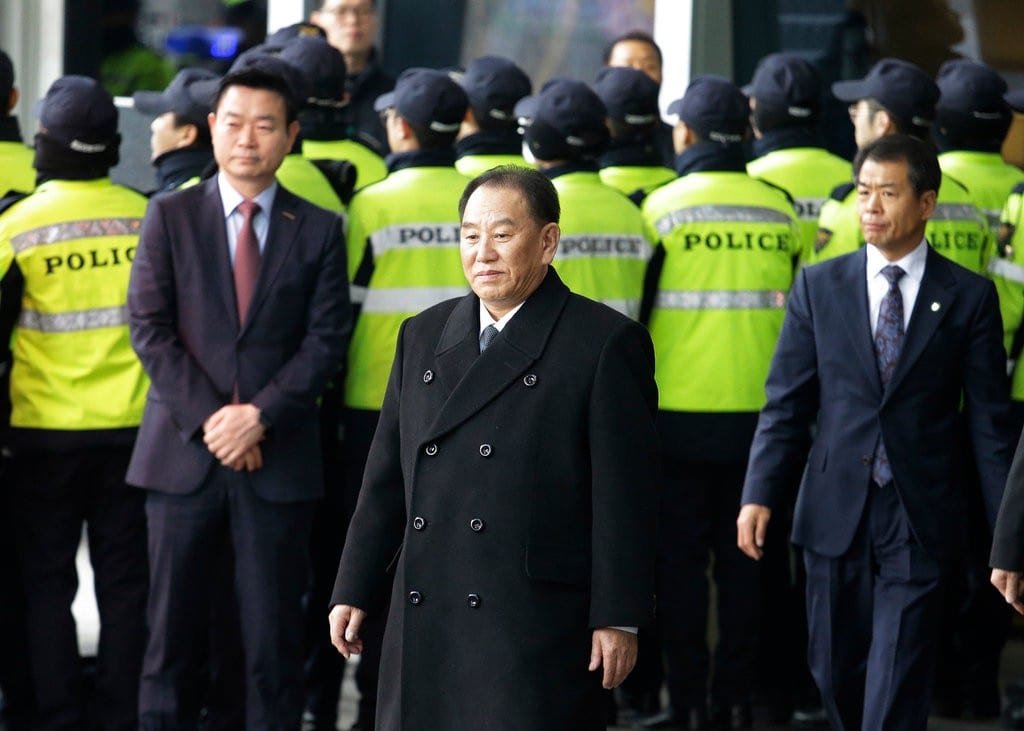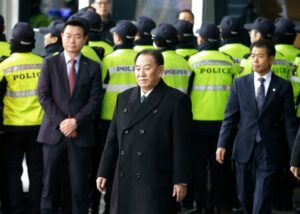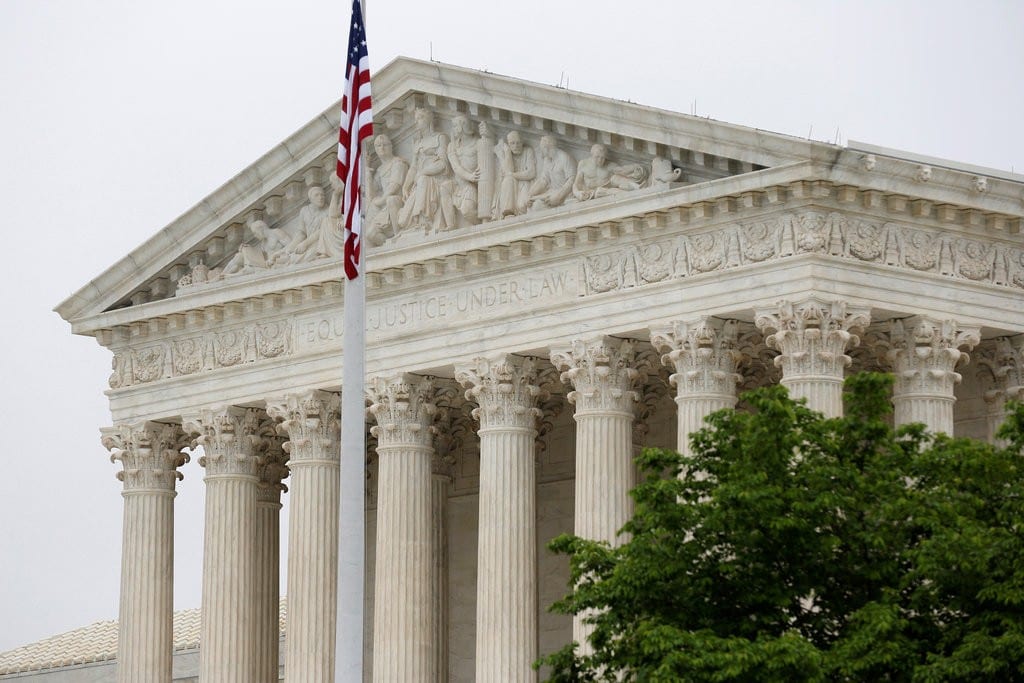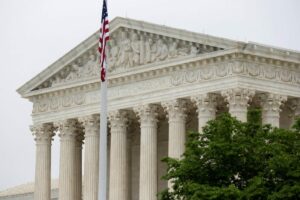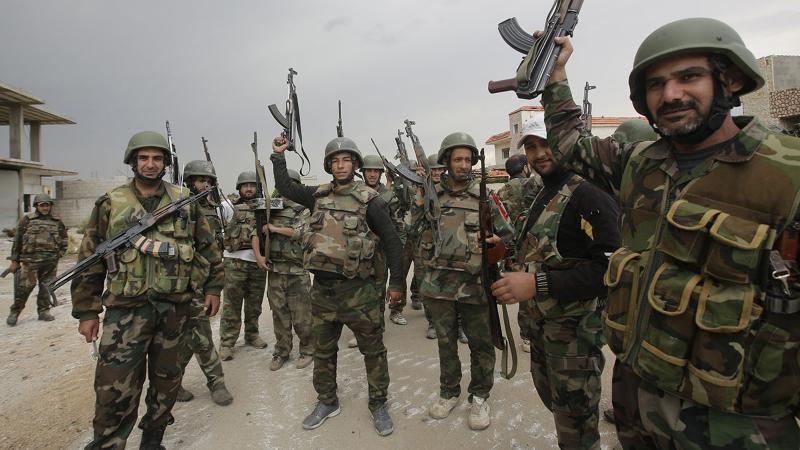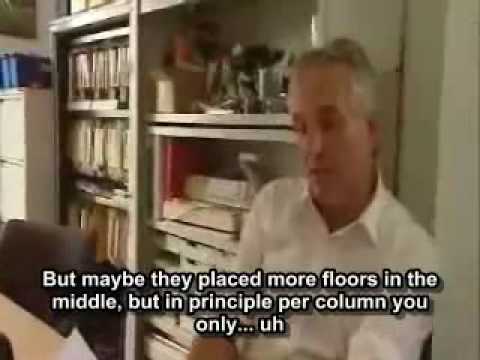La guerre de Syrie remet en cause l’ordre mondial unipolaire
7 avril 2018 Robert Bibeau
Par Elijah Magnier Le 2.04.2018. Sur Le Grand Soir.
Elijah Magnier a publié aujourd’hui un article en trois parties sur la guerre contre la Syrie et son rôle dans la compétition politique internationale :
Les Etats-Unis accepteront-ils leur défaite ou vont-ils défier l’ours russe et le dragon chinois ?
Partie 1, 2, 3 (en anglais).
La première partie décrit la situation actuelle sur les différents fronts en Syrie, et les développements ultérieurs les plus probables. Le gouvernement syrien est en train de gagner la guerre. Le général Votel de CentCom a reconnu que la stratégie américaine en Syrie avait échoué. Voilà la conclusion de Magnier à cette première partie :
Les Etats-Unis ont perdu la « bataille extrême » – ils se sont révélés incapables d’atteindre leur objectif de « changement de régime » en Syrie. L’ours russe s’est réveillé de sa longue hibernation lorsqu’il a réalisé que les Etats-Unis essayaient de l’isoler. Moscou s’est rapproché le dragon chinois, qui partage l’objectif de la Russie d’éliminer tous les extrémistes et les terroristes djihadistes en Syrie.
La Russie et la Chine travaillent maintenant en étroite collaboration pour modifier l’ordre unilatéral et mettre fin à la domination des États-Unis sur le monde entier.
La deuxième partie examine l’évolution des relations entre les États-Unis et la Russie au cours de la dernière décennie, et le rôle que les politiques étasuniennes de « changement de régime » en Europe de l’Est et au Moyen-Orient y ont joué. L’attaque étasunienne contre la Syrie s’inscrivait dans le cadre d’un défi plus large à la Russie. Elle a donné naissance à une nouvelle coalition qui s’oppose maintenant aux mouvements étasuniens :
Obama a vu l’État islamique se développer en Irak et s’installer en Syrie, il l’a regardé occuper l’Irak, il a laissé les djihadistes se rendre au Moyen-Orient, il a ouvert toutes les prisons saoudiennes à condition que les extrémistes djihadistes qui y étaient emprisonnés soient expédiés en Syrie. Pendant une année entière, malgré « 70 pays réunis dans une coalition luttant contre l’EI » en Syrie, le groupe EI a augmenté son emprise et ses revenus en vendant des quantités croissantes de pétrole. Tout cela pour arrêter l’Iran et la Russie, créer des États faillis (comme en Libye) et faire se battre les musulmans entre eux.
Mais Moscou, Pékin et Téhéran savaient qu’il fallait arrêter les djihadistes au Levant avant qu’ils n’arrivent dans leur propre pays.
…
La Syrie ne sera pas une autre Libye et la Russie, et la Chine ainsi que l’Iran ont décidé que la domination unilatérale des États-Unis s’arrêterait une bonne fois pour toutes aux portes du Levant
La troisième partie donne une vue d’ensemble encore plus large et montre comment la Chine et la coopération russo-chinoise parviennent à remettre en cause la domination unilatérale des États-Unis sur le globe :
Pendant que les Etats-Unis vendaient pour 110 milliards de dollars d’armes à l’Arabie Saoudite pour tuer davantage de Yéménites et menacer ses voisins (Qatar, Syrie et Iran), la Russie a signé des contrats pour 10 ans avec la Chine pour 600 milliards de dollars, et avec l’Iran pour 400 milliards de dollars. De plus, la Chine a signé avec l’Iran des contrats d’une valeur de 400 milliards de dollars. Ces contrats portent sur la coopération économique, les échanges énergétiques ; ils sont les prémices d’un avenir économique de très haut niveau pour ces pays bientôt libérés de la domination américaine.
Les États-Unis croient qu’ils peuvent isoler la Russie, la Chine et l’Iran : la Russie a une frontière de 7 000 kilomètres avec la Chine, l’Iran n’est pas l’Irak, et la Syrie n’est pas l’Afghanistan. En Syrie, il a été mis fin à la fatalité d’un monde gouverné unilatéralement par un empire hégémonique. Désormais le monde avance vers le pluralisme.
La grande question est celle-ci : Washington est-il prêt à accepter sa défaite, à reconnaître qu’il a perdu son contrôle sur le monde, et à se retirer de Syrie ?
En recevant récemment le dirigeant nord-coréen Kim Yong-un à Pékin, la Chine a remis en cause le rôle prépondérant des États-Unis dans les discussions sur la Corée du Nord. Il n’y aura pas de solution unipolaire de ce conflit – ni par des pourparlers, ni par la guerre. Un conflit au sujet de la Corée pourrait rapidement supplanter le conflit en Syrie en termes d’ampleur et de conséquences potentielles. Dans le contexte mondial, la guerre contre la Syrie n’est qu’un point de départ. Ce sera probablement en Corée, et peut-être à Taïwan, que se livrera la véritable bataille entre l’ordre unilatéral et l’ordre multilatéral.
Moon of Alabama
« Les Etats-Unis accepteront-ils leur défaite ou vont-ils défier l’ours russe et le dragon chinois ? »
1/3
Posted on 28/03/2018 by Elijah J Magnier

Published here: via @alraimediagroup
Damascus – from Elijah J. Magnier: @ejmalrai
Following the liberation of eastern Ghouta from the jihadists, and their departure to the northern city of Idlib under al-Qaeda and Turkish control, the city of Duma is now engaged in negotiations with the Russian side to find a way out for the militants of the “Army of Islam” (Jaish al-Islam). These militants fought against many jihadists and rebels and have therefore no remaining friends in the Syrian arena. However, this negotiation has become a tactical detail because the capital, Damascus, has become safe and is no longer exposed to daily shelling as was the case before the liberation of Ghouta.
Après la libération du Ghouta orientale depuis les djihadistes et leur départ pour la ville du Nord de Idlib sous al-Qaïda et le contrôle turc, la ville de la Douma est maintenant engagé des négociations avec la partie russe à trouver un moyen pour les militants de le « armée de l’Islam » (Jaish al-Islam). Ces militants ont lutté contre de nombreux djihadistes et rebelles et n’ont donc pas d’autres amis dans l’arène syrien. Toutefois, cette négociation est devenu un détail tactique, car Damas, la capitale, est devenu sûre et est n’est plus exposée à des bombardements quotidiens, comme ce fut le cas avant la libération de Ghouta.
What next?
The Yarmouk Camp and al-Hajar al-Aswad:
The elimination of the “Islamic State” group (ISIS) and the remnants of al-Qaeda in the Yarmouk camp and the nearby area of al-Hajar al-Aswad, south of Damascus, is also a tactical detail because there is no way out for these militants, trapped on all sides : the liberation of the area is not an issue.
The Syrian Steppe (al-Badiya):
In the Syrian steppes (al-Badiya), ISIS has still a pocket that the Syrian army is expecting to deal with this summer. This area is also totally besieged, ISIS can go nowhere and, while waiting, its willpower and morale are deteriorating and reaching a minimum level.
Le Camp de Yarmouk et al-Hajar al-Aswad :
l’élimination du groupe « Etat islamique » (ISIS) et les restes d’al-Qaïda dans le camp de Yarmouk et les environs d’al-Hajar al-Aswad, au sud de Damas, est également un détail tactique car il n’existe aucun moyen sur pour ces les militants, pris au piège de tous les côtés : la libération de la zone n’est pas un problème.
La Steppe syrienne (al-Badiya) : dans la steppe syrienne (al-Badiya), ISIS a toujours une poche que l’armée syrienne s’attend à faire face à cet été. Cette zone est aussi totalement assiégée, ISIS peut aller nulle part et, en attendant, sa volonté et le moral sont détériore et atteindre un niveau minimal.
Idlib and al-Qaeda:
As for the city of Idlib where the various opposition and jihadist forces are multiplying, the latter remain in a permanent power struggle that eats at each other. They will not be able to manage the presence of different nationalities and creeds opposing each other in one city. Therefore, the role of Turkey will be crucial in manoeuvring control in this area and prevent infighting among jihadists or even eliminate those unwilling to submit to Ankara’s policy.
The Turkish occupation forces:
The Turkish presence in the north-west and north-central has become inevitable. A long term but very slow and inconsistent battle is expected between the Turkish and Syrian states. It is natural in the circumstances to expect a threat and counter-threat by both governments.
Idlib et al-Qaeda:
Quant à la ville d’Idlib, où les différentes forces de l’opposition et les djihadistes sont multiplient, ce dernier reste une lutte de pouvoir permanent qui mange les uns les autres. Ils ne seront pas en mesure de gérer la présence de différentes nationalités et confessions s’opposant à l’autre dans une seule ville. Donc, le rôle de la Turquie sera cruciale en manoeuvres de contrôle dans ce domaine et éviter les luttes intestines entre les djihadistes ou même d’éliminer ceux qui refusent de se soumettre à la politique d’Ankara.
Les forces d’occupation turques :
la présence turque dans le Nord-Ouest et le centre-nord est devenu inévitable. Une bataille incompatible et à long terme mais très lent est prévu entre les États turque et syrienne. Il est naturel dans les circonstances d’attendre une menace et lutte contre la menace par les deux gouvernements.
If Damascus decides to opt for war against Turkey, it must deal with this issue without counting on its allies. Neither Russia nor Iran want a military confrontation with the Turkish army.Syria has the right to demand the restoration of its territory through diplomatic means first and then put pressure on Ankara through its allies and friends. The use of military force as a solution could then be adopted by Damascus as a final attempt to regain its territory in extremis.
Russia may be tempted to intervene diplomatically and find a solution between Damascus and Ankara if indeed Moscow’s aim is that it expects its forces to co-exist with the Syrian Army in a peaceful Syria.
Si Damas décide d’opter pour la guerre contre la Turquie, il faut traiter cette question sans compter sur ses alliés. Ni la Russie ni l’Iran veulent une confrontation militaire avec l’armée turque. La Syrie a le droit d’exiger la restauration de son territoire par des moyens diplomatiques tout d’abord, et ensuite, mettre la pression sur Ankara par le biais de ses alliés et amis. L’utilisation de la force militaire comme solution pourrait ensuite adoptée par Damas comme une ultime tentative de retrouver son territoire en extremis. La Russie peut-être être tentée d’intervenir diplomatiquement et de trouver une solution entre Damas et Ankara si en effet le but de Moscou est qu’elle attend ses forces à co-exister avec l’armée syrienne dans une Syrie Pacifique.
US occupation forces in Deir-Ezzour and al-Hasaka:
US forces remain in the north-east (almost 24% of the total Syrian territories under the US army’s control), with a large ISIS pocket protected by Washington at the present time “for undeclared reasons and objectives”. ISIS is deployed on the Syrian-Iraqi borders and conducts a « normal life » as they show in propaganda media adverts. Moreover, ISIS militants carry out insurgency attacks against the Syrian and the Iraqi Armies from both sides of the borders they are very familiar with.
It is most unlikely for the US forces to leave anytime soon unless forced to by insurgency attacks. They would want to avoid major casualties if and when the environment in which they exist becomes hostile.
Washington has proved it is capable of bearing losses, in Iraq. It remained despite the loss of about 4,500 troops and officers. As the ex-US Secretary of State James Baker said: ”America will go to war in the Middle East if necessary to control energy sources.”
Les forces américaines aux Deir-Ezzour et al-Hasaka:
Les forces américaines restent dans le nord-est (près de 24 % des territoires syriens totales sous contrôle de l’armée américaine), avec une grande poche à ISIS protégée par Washington à l’heure actuelle « pour des raisons non déclarées et objectifs ». ISIS est déployée à la frontière syrienne-iraquienne et mène une « vie normale », car ils montrent dans la propagande médiatique annonces. Par ailleurs, des militants de ISIS mener des attaques de l’insurrection contre le syrien et les armées irakiennes des deux côtés des frontières, ils sont très familiers avec. Il est peu probable pour les forces américaines de quitter n’importe quand bientôt à moins obligés par les attaques de l’insurrection. Ils voudraient éviter les grandes pertes lorsque l’environnement dans lequel ils existent devient hostile. Washington a prouvé qu’il est capable de supporter les pertes, en Irak. Il est resté, malgré la perte d’environ 4 500 soldats et officiers. Comme Secrétaire d’État James Baker des États-Unis a déclaré : « L’Amérique ira à la guerre au Moyen-Orient si nécessaire au contrôle des sources d’énergie. »
Indeed, in Syria, there are energy resources (oil and gas) under US control which amount to about 13 percent of the total Syrian stock. In addition, the US presence makes it easier for Israel to use a US established airport in north-east Syria as a hub on the Syrian-Iraqi border.
The United States can also reshuffle the situation in Iraq, Syria and Turkey to threaten all these countries with a possible “Kurdish state” since the local Kurds are those protecting and acting like US proxies. Even though, it is an unlikely scenario and the Kurds are expected to be abandoned by the US forces at a certain point and left to their destiny sometime in the future.
However, the US goals in occupied Syrian territory go against all the bordering countries and this may influence the duration of the US presence. There is no doubt that the US occupation of Syrian territory is very disturbing to the anti-American axis and is considered as a “poisonous thorn” in the Levant.
En effet, en Syrie, il sont a des ressources énergétiques (pétrole et gaz) sous contrôle des États-Unis qui s’élèvent à environ 13 pour cent de la population syrienne. En outre, la présence américaine rend plus facile pour Israël d’utiliser un aéroport américain établi en Syrie au nord-est comme une plaque tournante sur la frontière syrienne-irakienne.
Les Etats-Unis peuvent également remaniement la situation en Irak, Syrie et Turquie menacer tous ces pays avec un « Etat kurde » possible depuis les Kurdes les sont ceux qui protègent et agissant comme mandataires des Etats-Unis. Même si, c’est un scénario improbable et les Kurdes sont censés être abandonnés par les forces américaines à un moment donné et laissé à leur destin dans le futur.
Toutefois, les objectifs américains en territoire syrien occupé vont à l’encontre de tous les pays riverains, et cela peut influencer la durée de la présence américaine. Il n’y a aucun doute que l’occupation américaine du territoire syrien est très inquiétante pour l’axe anti-américain et est considérée comme une « épine toxique » dans le Levant.
On the other hand, the existence of ISIS has also become a small detail because it is besieged. It can move freely within the American enclave but cautiously toward its enemies: the Syrian and Iraqi armies. Therefore, it does not have any strategic horizon, especially since the Islamist card failed to change the Iraqi and the Syrian regimes. The “creative chaos” installed by the American establishment under the title of “The New Middle East” has also failed in its hoped for effect.
Daraa and Quneitra:
This does not mean Syria is liberated and that the control of the Syrian state extends over the entire Syrian territory. But there is an important battle coming up in the south of Syria in the Daraa and Quneitra provinces.
En revanche, l’existence d’ISIS est devenu aussi un petit détail, parce qu’elle est assiégée. Il peut se déplacer librement au sein de l’enclave américaine mais prudemment vers ses ennemis : les armées syrienne et irakienne. Par conséquent, il n’a pas tout horizon stratégique, surtout depuis la carte islamiste n’a pu changer les régimes syriens et irakien. Le « chaos créatif » installé par l’establishment américain sous le titre de « The New Middle East » a également échoué dans ses espérées pour effet.
Daraa et Quneitra : cela ne signifie pas la Syrie est libérée et que le contrôle de l’Etat syrien s’étend sur l’ensemble du territoire syrien. Mais il y a une bataille importante à venir dans le sud de la Syrie dans les provinces de Daraa et de Quneitra.
Why is this battle important, and more important than the pocket of ISIS in Yarmouk or the Syrian Steppe, or even more important than the city of Idlib, where Al Qaeda and other groups have gathered in the past two years?
The big dilemma remains for the two southern provinces: Daraa and Quneitra. These two provinces are on the border with Israel in the de-escalation zone agreed between the US, Jordan and the Russian.
But Damascus insists on liberating it with or without Russia’s approval. The Syrian government would also like to liberate that area which is under al-Qaeda, the rebels plus the one in the control of pro-ISIS militants of “Jaish Khaled bin Walid” .
And of course, as soon as we talk about the Syrian army liberating an al-Qaeda controlled territory, we can as usual expect an avalanche of accusations by the international media where the area will be portrayed as « lived in exclusively by over half a million civilians all defending their homes. »
Pourquoi est cette bataille importante et plus important que la poche d’ISIS à Yarmouk ou la Steppe syrienne ou plus important encore que la ville d’Idlib, où Al Qaeda et autres groupes sont réunis au cours des deux dernières années ? Le grand dilemme reste pour les deux provinces du Sud : Daraa et Quneitra. Ces deux provinces conviennent à la frontière avec Israël dans la zone de la désescalade entre les Etats-Unis, la Jordanie et la Russie.
Mais Damas insiste sur la libération il avec ou sans l’approbation de la Russie. Le gouvernement syrien tiens également libérer cette région qui se trouve sous al-Qaïda, les rebelles ainsi que celui du contrôle des militants pro-ISIS de « Jaish Khaled bin Walid ».
Et bien sûr, dès que nous parlons de l’armée syrienne, libérant un territoire d’al-Qaïda contrôlée, nous pouvons comme d’habitude attendre une avalanche d’accusations par les médias internationaux, où la zone sera présentée comme une « habité exclusivement par plus de la moitié d’un million civils tout ce que défendre leurs maisons. »
This manipulation of and by the media has been going on since the battles for Qusseyr, Qalamoun, Aleppo, Madaya and finally the battle of Ghouta. Washington has instructed the CIA, the Pentagon and the US State Department to use civilian tools with Non Governmental Organisations to raise human rights concern only against those countries who have rejected US dominance. This has been the case since the first day Russia set foot in Syria in September 2015, when it was undermined until the situation of the ground turned in favour of the Syrian government, and this is when serious criticism and attacks began against Russia and against Damascus’s allies in Syria.
For these particular reasons, Daraa must be the priority for the Syrian government to solve. It must initiate the negotiation to clear all militants willing to be dumped in Idlib – the « trash bin » destination where all jihadists are sent to from all the liberated areas of Syria.
Cette manipulation des et par les médias s’est passé depuis les batailles de Qusseyr, Qalamoun, Alep, Madaya et enfin la bataille de Ghouta. Washington a demandé à la CIA, le Pentagone et le département d’Etat américain à utiliser des outils civils avec des Organisations Non gouvernementales pour inquiéter des droits de l’homme que contre les pays qui ont rejeté la domination américaine. Cela a été le cas depuis la premier jour la Russie mis les pieds en Syrie en septembre 2015, quand il était sapée tant que la situation du sol tourné en faveur du gouvernement syrien, et c’est alors que sérieuses critiques et les attaques ont commencé contre la Russie et contre Alliés de Damas en Syrie. Pour ces raisons particulières, Daraa doit être la priorité pour le gouvernement syrien à résoudre. Il doit entamer la négociation pour effacer tous les militants prêts à immerger à Idlib – la destination « poubelle » où tous les djihadistes sont envoyés à partir de toutes les zones libérées de la Syrie.
The US has lost the « extremist battle »- they were incapable of achieving the “regime change” objective in Syria. That was the awakening of the Russian bear from its long hibernation who realised how the US was trying to corner it. Moscow also relied on the Chinese dragon, which shares Russia’s goals to eliminate all extremists and jihadist terrorists in Syria.
Both Russia and China are now working closely to put an end to the uni-polar superpower and thus end US world dominance.
Proof read by: Maurice Brasher
If you read this reporting and you like it, please don’t feel embarrassed to contribute and help fund it for as little as 1 Euro. Your contribution, however small will help ensure its continuity. Thank you.
Les États-Unis a perdu la « bataille d’extrémistes » – ils ont été incapables d’atteindre l’objectif de « changement de régime » en Syrie. C’était le réveil de l’ours russe de sa longue hibernation qui réalisa comment les États-Unis essayait de ce coin. Moscou a également invoqué le dragon chinois, qui partage les objectifs de la Russie d’éliminer tous les extrémistes et les terroristes djihadistes en Syrie.
La Russie et la Chine sont maintenant travaillant en étroite collaboration pour mettre un terme à la superpuissance unipolaire et ainsi mettre fin à la domination mondiale américaine.
La preuve lu par : Maurice Brasher
si vous lisez cette déclaration et vous l’aimez, s’il vous plaît ne se sentent pas gênés pour contribuer et aider à la financer pour aussi peu que 1 Euro. Votre contribution, si petite aidera à assurer sa pérennité. Merci.
Haut du formulaire
Bas du formulaire
In Portuguese:
By @DarioAlok
1 – …
2 – …
3 – …
2/3

Damascus – from Elijah J. Magnier: @ejmalrai
With the end of al-Ghouta battle and the defeat of Jihadists, Moscow is reaching its objectives in the Levant.
Despite the US, the EU and the mainstream media gathering to attack him and try to demonise his policy, the Russian President Vladimir Putin can now say:”veni, vidi, vici”.
The US estimated that Russia, by 2020, would be too strong militarily and economically to be isolated or weakened. This is why Washington tried its best to surround Russia and “cut its legs off” much before and close the oceans toits commerce and to its Chinese ally.
The last US attack, while hiding behind the EU, to attract Ukraine intothe European orbit and stop the flow of the Russian gas to Europe – a vital resource of the Russian economy – was in 2014 and this pushed the Russian bear to wake up and decide to act and react accordingly.
Moreover, in 2015, the US strikes a nuclear deal with Iran – putting an awful lot of pressure on the EU to accelerate its approval and finalise the deal – in an attempt to separate Iran from Russia. However, the Iranian Leader Sayyed Ali Khaminei was adamant: “There would be no talks involving any other dossier than the nuclear one. We don’t and will never trust the Americans”.
Avec la fin de la bataille d’al-Ghouta et la défaite de djihadistes, Moscou est d’atteindre ses objectifs dans le Levant. Malgré les États-Unis, l’Union européenne et les grands médias, rassemblement pour l’attaquer et tenter de diaboliser sa politique, le Président russe Vladimir Putin peut maintenant dire : « veni, vidi, vici ». Aux États-Unis a estimé que la Russie, d’ici à 2020, serait trop forte militairement et économiquement à être isolé ou affaiblie. C’est pourquoi Washington a essayé de son mieux pour encercler la Russie et « couper ses jambes » beaucoup avant et fermer les océans à son commerce et son chinois allient. La dernière attaque américaine, tout en se cachant derrière l’UE, pour attirer l’Ukraine dans l’orbite européenne et arrêter l’écoulement du gaz russe vers l’Europe – une ressource vitale de l’économie russe – était en 2014 et cela a poussé la Russie portent pour réveiller et décider d’agir et de réagir selon ly. En outre, en 2015, les Etats-Unis frappe un accord nucléaire avec l’Iran – mettre énormément de pression sur l’Union européenne à accélérer son approbation et finaliser la transaction – dans une tentative…
Cependant, les Iraniens Leader Sayyed Ali Khaminei a été catégorique : « il n’y aurait aucune négociation impliquant n’importe quel autre dossier, celui du nucléaire. Nous n’et n’approuveront jamais les américains ».
The US looked like a generous donor helping Iran to reopen its doors to the world without paying any price in Washington. This is why Donald Trump is now trying to find ways to revoke it, a deal he sees of financial and political benefit only to Europe and not to the United States. Iran is ready for a partnership with Europe but rejects US dominance.
Trump is even blackmailing Europe by threatening to impose high taxes on its products if the old continentdoesn’t go along with the US policy. He has asked the European countries to decide : either they prefer to do business with Iran or with the United States.
President Trump has not understood, to date, that with or without the nuclear deal, Iran is heading towards a wide partnership with Russia and China. Beijing needs a reliable source of energy, an exit to the oceans and a window to the Mediterranean market. Iran can provide that and enjoy the colossal Chinese economic benefits, its market, and its support.
Les États-Unis ressemblaient à un généreux donateur aider l’Iran à rouvrir ses portes au monde sans avoir à payer n’importe quel prix à Washington. C’est pourquoi Donald Trump essaie maintenant de trouver des façons de les révoquer, une affaire, il voit des avantages financiers et politiques seulement vers l’Europe et non aux États-Unis. L’Iran est prêt à un partenariat avec l’Europe mais rejette la domination américaine. Trump est même exercer un chantage sur l’Europe en menaçant d’imposer des taxes élevées sur ses produits si le vieux continent ne va pas avec la politique américaine. Il a demandé les pays européens de décider : soit ils préfèrent faire des affaires avec l’Iran ou avec les États-Unis. Le Président Trump n’a pas compris, à ce jour, que, avec ou sans l’accord sur le nucléaire, l’Iran se dirige vers un large partenariat avec la Russie et la Chine. Beijing a besoin d’une source fiable d’énergie, une sortie vers les océans et une fenêtre sur le marché méditerranéen. Iran peut prévoir qu’et apprécier les avantages économiques chinois colossales, son marché et son soutien.
Iran didn’t only accept President Obama’s gift, it decided to face the US on the battlefield through the US’s Syrian proxies and its plans to destabilise the Levant. By sending Iranian Special Forces and relying on its allies (Hezbollah, Iraqi groups and others), Iran and Russia managed to defeat ISIS and al-Qaeda in many battles in Syria, Iraq and Lebanon.
The US lost one Syrian city after another despite its hopeless attempts at the UN, and despite its arming of the jihadists. The US asked Europe to open its doors to allow radicals to take the step of becoming jihadist extremists and go into action. It also, over the years, asked Turkey to open its borders to allow the flow of these future jihadists and old al-Qaeda guards to move by waves into Syria to destabilise the Syrian government.
Not only that, it has offered its CIA training to jihadists in Jordan and Turkey and asked Saudi Arabia and Qatar to pay billions of dollars to promote the success of “The New Jihadist Middle East”. And lastly, the US is manipulating the mainstream media. For the first time in history, we see a general manipulation of the media in a democratic country, with loss of credibility, much turning of « blind eyes » and fake news – and not just regarding Syria.
L’Iran n’a pas accepté seulement cadeau du président Obama, il a décidé de faire face aux Etats-Unis sur le champ de bataille à travers les Etats-Unis du syrien proxies et ses plans visant à déstabiliser le Levant. En envoyant des Forces spéciales iraniennes et en s’appuyant sur ses alliés (le Hezbollah, des groupes irakiens et autres), l’Iran et la Russie a réussi à vaincre ISIS et al-Qaïda à de nombreuses batailles en Syrie, Irak et Liban. Les États-Unis a perdu une ville syrienne après l’autre malgré ses tentatives désespérées à l’ONU, et son armement des djihadistes. Les Etats-Unis a demandé à l’Europe à ouvrir ses portes pour permettre des radicaux pour passer à l’étape de devenir extrémistes djihadistes et passer à l’action. Il également, au cours des années, a demandé à la Turquie d’ouvrir ses frontières pour permettre l’écoulement de ces futurs djihadistes et anciens gardes d’al-Qaïda de passer par les vagues en Syrie de déstabiliser le gouvernement syrien. Non seulement, il a offert sa formation de CIA de djihadistes en Jordanie et en Turquie et a demandé l’Arabie saoudite et le Qatar à payer des milliards de dollars pour favoriser la réussite de « The New Jihadist Middle East. Et enfin, aux États-Unis sont de manipuler les médias traditionnels. Pour la première fois dans l’histoire, nous voyons une manipulation générale des médias dans un pays démocratique, avec une perte de crédibilité, beaucoup de tournage de « les yeux des aveugles » et fausses nouvelles – et pas seulement en ce qui concerne la Syrie.
Moscow, Damascus and Tehran rejected many “red lines” imposed by the US on Syria (on the Tanf Syrian-Iraqi borders, the US forces imposed a safety parameter of 50 miles. Iran kept the distance but surrounded the US forces from the north, west and south). In fact, the war in Syria was far from being a civil war but the transposition of a worldwide war between two axes: but only one can win.
Russia moved forward and concluded a deal with the Syrian government to exploit its oil and gas resources. Iin Syria, energy wealth is estimated as follows: 63% on land and 37% in the Mediterranean, in the 14 richest blocks opposite Tartus and Lattakia with a production estimated above that of Kuwaiti oil production. On land, Syria’s energy is distributed as follow: 47% in al-Badiya, 2% in Aleppo, 12% in Deir-Ezzour, and 2% in the Golan. Syria can compete with Iraq and even Iran, with its energy in full production once the war is over.
The US establishment is finding it difficult to digest seeing this huge fortune in the hands of a Syrian government, and an ally of Russia and Iran, and, which above all, rejects US dominance and control.
Moscou, de Damas et de Téhéran a rejeté plusieurs « lignes rouges » imposées par les Etats-Unis sur la Syrie (aux frontières syrienne Tanf iraquiens, les forces américaines ont imposé un paramètre de sécurité de 50 milles. Iran gardé la distance mais entouré des forces américaines du Nord, Ouest et Sud). En fait, la guerre en Syrie était loin d’être une guerre civile mais la transposition d’une guerre mondiale entre deux axes : mais seul peut gagner. La Russie avance et conclut une entente avec le gouvernement syrien à exploiter ses ressources pétrolières et gazières. IIN Syrie, richesse de l’énergie est estimée comme suit : 63 % sur terre et 37 % en Méditerranée, dans les 14 blocs plus riches en face de Tartous et Lattaquié, avec une production estimée supérieure à celle de la production de pétrole koweïtien. Sur terre, l’énergie de la Syrie est distribué comme suit : 47 % en al-Badiya, 2 % à Alep, Deir Ezzour 12 % et 2 % dans le Golan. La Syrie peut rivaliser avec l’Irak et l’Iran même, avec son énergie en pleine production, une fois la guerre terminée. La mise en place aux États-Unis a du mal à digérer voir th.
Actually, in 2006, the ex-US Secretary Condoleezza Rice said: ”It is time for a new Middle East…We shall win, they shall lose”. It was the time Israel attacked Lebanon so the country submitted to US control and dominance. Israel failed when the Lebanese resistance stood against its attempt to invade the country for the third time and the “axis of the resistance” prevailed. This pushed the US to use different tactics (called “the soft war”), relying on proxies and locals in the Middle East rather than pushing its own army that drastically failed in Afghanistan and Iraq.
It was clear that Washington is militarily capable of invading any country in the Middle East but it can’t keep its forces there for long. This is when it was necessary for the US establishment to use more subtle technique: “cold steel”, rather than firearms They promoted the slogan of “democracy” or “freedom of expression”, or “freedom of religion”, or even « allowing youths to express their concern about human rights »
En fait, en 2006, Secrétaire d’État Condoleezza Rice des États-Unis a déclaré : « il est temps pour un nouveau Moyen-Orient… Nous allons gagner, ils perdront ». C’était que le temps Israël attaqué Liban alors que le pays nous soumis à contrôle et domination. Israël a échoué lorsque la résistance libanaise s’élevait contre sa tentative d’envahir le pays pour la troisième fois et « l’axe de la résistance » a prévalu. Cela a poussé les Etats-Unis à utiliser des tactiques différentes (appelés « la guerre douce »), en s’appuyant sur les procurations et les habitants du Moyen-Orient plutôt que de pousser sa propre armée qui n’a pas radicalement en Afghanistan et en Irak. Il était clair que Washington est militairement capable d’envahir tous les pays du Moyen-Orient, mais il ne peut pas garder ses forces pour longtemps. C’est quand il était nécessaire pour la mise en place aux États-Unis d’utiliser plus subtile technique : « cold steel », plutôt que des armes à feu, ils ont promu le slogan de la « démocratie » ou « liberté d’expression », ou « la liberté de religion », ou même « permettant aux jeunes d’exprimer leur préoccupation sur les droits de l’homme »
All these were fake slogans – regardless of their righteous titles – and were directed towards every single country unwilling to accept the US policy and control. This is where the “Arab Spring” (or Tsunami) hit the Middle East with the support of the US Secretary of State and the CIA who financed “schools of revolution and activism”.
Tous ces étaient fausses slogans – quelles que soient leurs titres justes – et ont été dirigés vers chaque pays refuse d’accepter la politique américaine et le contrôle. C’est où le « Printemps arabe » (ou Tsunami) a frappé le Moyen-Orient, avec le soutien de la Secrétaire d’Etat américaine et la CIA qui a financé les « écoles de la révolution et l’activisme ».

Revolutions were a new phenomena using one slogan with different colours and were called the “Colour revolutions”: in Georgia (Rose), Ukraine (Orange), Iraq (Purple), Kyrgyzstan (Tulip), Lebanon (Cedar), Belarus (Jeans), Iran (Green), Egypt (Lotus)…
In the Middle East, the US called Google for help, supported social media availability and investing 30 million dollars to support Muslim youth through the internet and invited activists to rise in their respective countries. In June 2011, US Secretary of State Hillary Clinton described the internet as “the Che Guevara of the 21st century in the Arab Spring uprisings”.
George W. Bush, Barack Obama and now Donald Trump all are following the same policy with different tactics, opening the road to changes in the Middle East by trying to remove dictators and replace these with Jihadists or with other dictators. The “management of savagery” (attributed to al-Qaeda and speaking about how to create a failed state and take advantage by moving towards the leadership of the country) was more applied by the US establishment than by the jihadists who wrote about it.
Révolutions étaient un phénomène nouveau en utilisant un slogan avec différentes couleurs et s’appelaient les « révolutions de couleur » : en Géorgie (Rose), Ukraine (Orange), Irak (violet), Kirghizistan (tulipe), Liban (cèdre), Bélarus (Jeans), Iran (vert), Egypte (Lotus)… Au Moyen-Orient, les États-Unis appelé Google à l’aide, prise en charge de disponibilité des médias sociaux et investir 30 millions de dollars pour soutenir la jeunesse musulmane par le biais de l’internet et les militants invités à monter dans leurs pays respectifs. En juin 2011, Secrétaire d’Etat américaine Hillary Clinton a décrit l’internet comme « le Che Guevara du XXIe siècle dans les soulèvements du printemps arabe ». Bush, Barack Obama et maintenant de Donald Trump tous suivent la même politique avec des tactiques différentes, ouvrant la voie à des changements au Moyen-Orient en essayant de supprimer les dictateurs et remplacer ces djihadistes ou avec d’autres dictateurs. La « gestion de sauvagerie » (attribuée à al-Qaïda et parler de comment créer un échec d’État et profiter en déplaçant envers…
Obama saw the “Islamic State” growing in Iraq, moving to Syria, watched it occupying Iraq, allowed Jihadists to travel to the Middle East, opened all Saudi jails on condition jihadist extremists imprisoned are shipped to Syria. For one entire year, with “70 countries in a coalition fighting against ISIS” in Syria, the group was in fact expanding and increasing its wealth by selling increasing quantities of oil. All that to stop Iran and Russia, and create failed states (as in Libya) and fight Muslims with Muslims.
But Moscow, Beijing and Tehran knew that Jihadists must be stopped in the Levant before they had the chance to move to their own countries. Of course, President Medvedev made a mistake in 2010 by allowing the fall of Libya and with it the severance of an important source of energy. The US and the EU were fully aware of the presence of extremists in Benghazi but, regardless, have supported these extremists and allowed the destruction of the Libyan army at the beginning of the “Revolution”.
Obama a vu la culture de « Etat islamique » en Irak, se déplaçant vers la Syrie, ont regardé il occupant l’Irak, a permis des djihadistes pour se rendre au Moyen-Orient, a ouvert à toutes les prisons saoudiennes sur djihadiste condition extrémistes emprisonnés sont expédiées vers la Syrie. Pour une année entière, avec « 70 pays dans une coalition luttant contre ISIS » en Syrie, le groupe était en fait en expansion et augmenter sa richesse en vendant des quantités croissantes de pétrole. Tout ça pour arrêter l’Iran et la Russie et créer des États défaillants (comme en Libye) et combattre les musulmans avec les musulmans. Mais Moscou, Pékin et Téhéran savaient que les djihadistes doivent être arrêtés dans le Levant avant d’avoir la chance de se déplacer dans leur propre pays. Bien sûr, le président Medvedev a fait une erreur en 2010 en permettant à la chute de la Libye et avec lui la rupture d’une source importante d’énergie. Les Etats-Unis et l’UE étaient pleinement conscients de la présence d’extrémistes à Benghazi mais, quelles que soient, ont soutenu ces extrémistes et a permis la destruction de l’armée libyenne au début de la…
Lebanon, before Libya, managed to stay away from the US’s orbit and Russia, in 2006, was not yet ready to punch according to its weight. Libya was a Russian and a Chinese mistake at the UN and Russia believed it was not possible to do something to stop the process. But Syria is not going to be another Libya and Russia and China agreed, along with Iran, to stop once and for allthe US unilateral dominance at the gates of the Levant.
Part 3 to follow.
Proof read by: Maurice Brasher
If you read this reporting and you like it, please don’t feel embarrassed to contribute and help fund it for as little as 1 Euro. Your contribution, however small will help ensure its continuity. Thank you.
Liban, avant la Libye, a réussi à rester à l’écart des États-Unis pour l’orbite et la Russie, en 2006, n’était pas encore prête à perforer selon son poids. La Libye était un russe et une erreur chinoise à l’ONU et la Russie croyait qu’il n’était pas possible de faire quelque chose pour arrêter le processus. Mais la Syrie ne va pas être une autre Libye et la Russie et la Chine ont convenu, ainsi que de l’Iran, pour arrêter une fois pour toutes la domination unilatérale américaine aux portes du Levant.
Partie 3 à suivre.
si vous lisez cette déclaration et vous l’aimez, s’il vous plaît ne se sentent pas gênés pour contribuer et aider à la financer pour aussi peu que 1 Euro. Votre contribution, si petite aidera à assurer sa pérennité. Merci.
Haut du formulaire
Bas du formulaire
In Portuguese:
By @DarioAlok
1 – …
2 – …
3 – …
3/3
Posted on 28/03/2018 by Elijah J Magnier

Damascus – from Elijah J. Magnier: @ejmalrai
Russia introduced China to Syria during the war when the Chinese navy arrived in the Mediterranean and reached the shores of Tartous and Lattakia to send a message to America and its allies that the monolithic dominance of the world was over.
There are thousands of Chinese jihadists who fought with ISIS and al-Qaeda and Beijing was concerned, willing to see all these killed in Syria. Cooperation between the Chinese and the Syrian intelligence services was established. Damascus has a unique and a very rich bank of information about foreign fighters many countries in the world would like to have access to, since over 80 nationalities of foreign fighters were allowed into Syria in a failed attempt to topple the regime and establish an Islamic State.
La Russie a présenté Chine en Syrie pendant la guerre quand la marine chinoise sont arrivés en Méditerranée et atteint les côtes de Tartous et Lattaquié pour envoyer un message à l’Amérique et ses alliés qui prit fin la domination monolithique du monde. Il y a des milliers de chinois djihadistes qui ont combattu avec ISIS et al-Qaïda et Pékin portait, désireux de voir tous ces tués en Syrie. Coopération entre les chinois et les services de renseignement syrien a été créée. Damas a un unique et une banque très riche d’informations sur les combattants étrangers de nombreux pays dans le monde voudrais avoir accès, puisque plus de 80 nationalités de combattants étrangers ont été autorisées en Syrie dans une tentative de renverser le régime et d’établir un État islamique.
But Washington is still trying to protect its position, refusing to give up on the crown of world domination it has enjoyed for over a decade and it is ready to fight against the “axis opposing the US” using other means outside Syria. The US establishment and its allies are expelling Russian diplomats and imposing sanctions on China and Iran. The US defeat in Syria is obviously very painful.
What Washington is pretending to ignore is that the world no longer believes in the US’s military muscles and that there are two potential countries, less arrogant and willing to create alliances rather than bullying weaker countries: Russia and China. These are gathering more allies against the US axis.
Mais Washington cherche toujours à protéger sa position, refusant de renoncer à la Couronne de domination mondiale elle jouit de plus d’une décennie et il est prêt à se battre contre « l’axe s’opposant aux États-Unis » par d’autres moyens à l’extérieur de la Syrie. La mise en place aux États-Unis et ses alliés sont expulser des diplomates russes et imposant des sanctions contre la Chine et l’Iran. La défaite des Etats-Unis en Syrie est évidemment très douloureuse. Ce que Washington fait semblant d’ignorer, c’est que le monde ne croit plus aux États-Unis de muscles militaires et qu’il y a deux pays potentiels, moins arrogantes et désireux de créer des alliances, plutôt que de pays plus faibles de l’intimidation : la Russie et la Chine. Ceux-ci sont regroupent plus d’alliés contre l’axe US.
The US is still living in the era of 1991 when the Soviet Union collapsed. Its strong decline continued until the arrival of President Vladimir Putin to power in 2000. Washington realised there is a new person at the Kremlin in the castle of the Tsars with a determined intention to restore the lost glory. Russia had only nuclear weapons at that time and nothing else but the will was strong for the Russian bear to wakeup from its hibernation.
Putin did not declare war on America but extended his hand and tried to build friendship or at least not enmity. But Washington saw in Moscow the potentiality to recover in a couple of decades and worked on slowing down the process or interrupting it if possible. This is why the US started to pull to its side many countries of the ex-Soviet Union which have declared independence and include these in NATO and in the European Union surrounding Russia.
Les États-Unis vit encore à l’ère de 1991 lorsque l’Union soviétique s’est effondrée. Sa forte baisse s’est poursuivie jusqu’à l’arrivée du président Vladimir Putin au pouvoir en 2000. Washington a réalisé il y a une nouvelle personne au Kremlin dans le château des Tsars avec une intention déterminée pour restaurer la gloire perdue. La Russie avait seulement des armes nucléaires à ce moment-là et rien d’autre, mais la volonté était forte pour l’ours russe à la réactivation de son hibernation. Poutine n’a pas déclaré la guerre sur l’Amérique mais tendit la main et a essayé de construire l’amitié ou du moins pas d’inimitié. Mais Washington a vu à Moscou la potentialité de récupérer dans une vingtaine d’années et a travaillé sur la ralentir ou interrompre si possible. C’est pourquoi les Etats-Unis ont commencé à tirer vers son côté nombre de pays de l’ex-URSS qui ont déclaré l’indépendance et inclure ces derniers dans l’OTAN et dans l’Union européenne autour de la Russie.
China, which includes cheap labor and can clone any commercial or military technology, like Russia has perceived America’s fear of its rapid economic development and wealth. Thus, the Chinese-Russian rapprochement was mainly created by the aggressive US policy towards the two countries, and this mainly because the American concentrate exclusively on military muscle when dealing with the World.
Washington has focused its naval control over the South China Sea and the Straits of Malacca, bringing back memories of its military presence during the Second World War with the attempt to tighten its pressure on Beijing. The US is aware of their naval superiority and know that China needs the sea for its commerce and for its supply of energy.
La Chine, qui comprend la main-d’œuvre bon marché et permet de cloner n’importe quelle technologie militaire ou commercial, comme la Russie a perçu la peur de l’Amérique de son développement économique rapide et de la richesse. Ainsi, le rapprochement de la Chine et la Russie a été principalement créé par la politique américaine agressive envers les deux pays et ce principalement parce que les militaires américains concentré exclusivement sur le muscle lorsqu’il s’agit du monde. Washington a porté son contrôle naval de la mer de Chine du Sud et le détroit de Malacca, ramener des souvenirs de sa présence militaire au cours de la seconde guerre mondiale avec la tentative de renforcer sa pression sur Pékin. Les États-Unis sont conscients de leur supériorité navale et savent que la Chine doit la mer pour son commerce et son approvisionnement en énergie.

China started to protect itself by setting up the Eurasian political and economic Shanghai Cooperation Organisation in June 2001 with the goal also to focus on economic initiatives, increase military and counter terrorism cooperation with intelligence sharing. This Cooperation includes about half of the World’s total population and the states (including five nuclear states) of China, Russia, Kazakhstan, Tajikistan, Uzbekistan, Kyrgyzstan, Mongolia, Iran, India and Pakistan – and rejected Washington’s and Tokyo’s request to be observers only.
China has gone to the countries affected by US policy to establish a rapprochement. Further, it established the “string of Pearls” of states and islands for marine protection and encircled India, Japan and other American allies.
La Chine a commencé à se protéger en mettant en place l’Organisation de coopération de Shanghai politique et économique eurasienne en juin 2001 dans le but également de se concentrer sur des initiatives économiques, augmenter la coopération militaire et contre le terrorisme avec l’échange de renseignements. Cette coopération comprend environ la moitié de la population totale du monde et des États (y compris les cinq puissances nucléaires) de la Chine, la Russie, Kazakhstan, Tadjikistan, Ouzbékistan, Kirghizistan, Mongolie, Iran, Inde et Pakistan – et rejeté de Washington et de Tokyo demande à être des observateurs seulement. La Chine est allé vers les pays touchés par la politique américaine d’établir un rapprochement. En outre, elle a créé le « collier de perles » des États et des îles pour la protection du milieu marin et encercle par Inde, Japon et autres alliées de l’Amérique.
The Indian Ocean sees the passage of 60% of the trade in oil from the Middle East, making the Straits of Malacca indispensable for China to protect. Therefore Beijing established relationships with Malaysia, Singapore, Myanmar, Coco islands, Bangladesh, Sri Lanka, Pakistan, and a presence in the African coast in Sudan and Kenya.
L’océan Indien voit le passage de 60 % du commerce du pétrole du Moyen-Orient, rendant le détroit de Malacca indispensable pour la Chine à protéger. Beijing a donc établi des relations avec la Malaisie, Singapour, Myanmar, Coco îles, Bangladesh, Sri Lanka, au Pakistan et une présence sur la côte africaine au Soudan et au Kenya.

Moreover, China revived the world’s oldest overland trade route of the Han Dynasty called “the Silk Road”. The modern Chinese Silk Road will provided a link to Beijing with the world for trade expected worth one trillion dollars (for 900 separate projects). The Silk Road reaches 11 cities in Europe and others in Africa by railway and pipeline and is expected to bring together seven Asian countries under the slogan “One Belt, One Way”. It will offer gas and trade to China and will cover 70% of the planet’s population.
En outre, la Chine relancé plus vieux commerce route terrestre du monde de la dynastie Han, appelée « route de la soie ». Route de la soie chinoise moderne seront dotés d’un lien à Pékin avec le monde du commerce attendu d’une valeur de 1 billion de dollars (pour 900 projets distincts). La route de la soie atteint 11 villes en Europe et d’autres en Afrique par chemin de fer et de pipeline et devrait réunir des sept pays d’Asie sous le slogan « Une courroie, One Way ». Il offrira des gaz et le commerce en Chine et couvrira 70 % de la population de la planète.

China is also part of the BRICS Group, which was established in 2009 and includes Brazil, Russia, India, China and South Africa, which account for about 40 percent of world production.
La Chine fait également partie du groupe BRIC, qui a été créé en 2009 et qui comprend le Brésil, Russie, Inde, Chine et Afrique du Sud, qui représentent environ 40 pour cent de la production mondiale.

And last but not least, in 2013, China presented the Asian World Bank (AIIB) that was set up to strike America at the core and bring together 57 countries – including several European states – but excluding the United States and Japan, its staunch ally.
Et enfin et surtout, en 2013, la Chine a présenté la Banque mondiale (AIIB asiatique) qui a été mis en place pour frapper l’Amérique au coeur et à rassembler des 57 pays – y compris plusieurs Etats européens – mais à l’exclusion des États-Unis et au Japon, son allié indéfectible.

The Asian International Bank – with $100 billion – aims to get rid of American financial control over the world’s economy. Washington considered this move as provocative, aiming at finding alternatives to its control of the world’s economy and financial that the United States has controlled for decades without any rival.
With its superficial but continuous sanctions, Washington believes it is capable of preventing the Eurasia Union (which begins from the Atlantic Ocean to the Indian Ocean, including six large states containing 3/4 of the world’s energy), to trouble Russia and to bother China.
La Banque asiatique de International – avec 100 milliards de dollars, vise à se débarrasser du contrôle financier américain sur l’économie mondiale. Washington a considéré ce mouvement comme une provocation, visant à trouver des solutions de rechange à son contrôle de l’économie mondiale et financier que les États-Unis a contrôlé pendant des décennies sans aucun rival. Avec ses sanctions superficielles mais continues, Washington estime qu’il est capable d’empêcher l’Union de l’Eurasie (qui commence de l’océan Atlantique à l’océan Indien, y compris six grands États contenant 3/4 de l’énergie mondiale), à la Russie de l’ennui et à peine de Chine.
Moreover, the US was thinking of creating a “Middle Eastern NATO” to counter the “Shiite crescent” and the “Iranian threat”. This idea was destroyed following the Saudi Arabia disastrous war on Yemen and because Middle Eastern countries are unable to unite politically, economically or militarily.
While the US is fighting and losing in Syria, most countries that rejected American hegemony are gathering together in one way or another. There is cooperation between these countries – as we saw above – to get rid of Washington’s dominance, arrogance and destructive foreign policy.
En outre, les États-Unis pensait de la création d’une « OTAN du Moyen Orient » pour contrer le « croissant chiite » et la « menace iranienne ». Cette idée a été détruite après la guerre désastreuse de l’Arabie saoudite sur l’Yémen et parce que les pays du Moyen-Orient sont incapables de s’unir politiquement, économiquement et militairement. Alors que les États-Unis sont combats et perdre en Syrie, la plupart des pays qui rejettent l’hégémonie américaine sont rassemblant d’une manière ou d’une autre. Il y a coopération entre ces pays – comme nous l’avons vu ci-dessus – se pour débarrasser de la domination, l’arrogance et destructrice de politique étrangère de Washington.
The US believes in changing regimes and directly – or through proxies – to occupy or control countries and impose a heavy protection fee to avoid toppling Middle Eastern monarchies (like Saudi Arabia as Donald Trump said himself). The US establishment is also manipulating youth and exploiting it under the title “Freedom activists” to guide them towards failing states, allowing extremists (Libya and both Syria and Iraq) to just get away with it).
America is deploying missiles everywhere where its military bases are deployed all over the world and has never thought of using its energy and power to support the economy and peace. It is only focused on controlling states and the sources of energy regardless of the consequences, because there is no accountability for its doing.
Les États-Unis croit dans l’évolution des régimes et directement- ou par l’intermédiaire de serveurs proxy – d’occuper ou de contrôler le pays et imposer un lourd protection frais pour éviter le renversement des monarchies du Moyen-Orient (comme l’Arabie saoudite comme Donald Trump dit lui-même). The US mise en place est également manipuler les jeunes et l’exploiter sous le titre « Les activistes de la liberté » pour les guider vers les États défaillants, permettant aux extrémistes (Libye et Syrie et Irak) pour simplement sortir avec elle). L’Amérique se déploie des missiles partout où ses bases militaires sont déployés partout dans le monde et a jamais pensé à utiliser son énergie et puissance pour soutenir l’économie et la paix. Il est uniquement focalisée sur la lutte contre les États et les sources d’énergie peu importe les conséquences, car il n’y a aucune responsabilité pour son accomplissement.
Failure is everywhere: Washington’s plan failed- as General Wesley Clark, retired 4-star U.S. Army general, Supreme Allied Commander of NATO during the 1999 War on Yugoslavia said – to occupy seven countries (Iran, Iraq, Syria, Lebanon, Libya, Somalia and Sudan), and its failure in Afghanistan, Iraq and Syria because it underestimated the reaction to its foreign policy.
However, it has largely succeeded in planting hate among the Muslim population, turning the objective of al-Qaeda (its goal to target the far enemy, i.e. the US) and replaced it with ISIS (the goal is to target the near enemy, i.e. minorities and other Muslims), reviving an animosity between Muslims that is 1400 year old. Today the majority of the western population believes the war in the Middle East is “between Muslims. Let them kill each other…who cares?”.
Défaillance est partout : plan de Washington a échoué-comme le général Wesley Clark, à la retraite 4 étoiles US Army, commandant général, suprême des forces alliées de l’OTAN pendant la guerre de 1999 sur l’Yougoslavie a dit – d’occuper de sept pays (Iran, Irak, Syrie, Liban, Libye, Somalie et Soudan), et son échec en Afghanistan, Irak et Syrie parce qu’il a sous-estimé la réaction de sa politique étrangère. Toutefois, il a largement réussi à planter la haine parmi la population musulmane, en tournant l’objectif d’al-Qaïda (son objectif pour cible l’ennemi lointain, c’est-à-dire aux États-Unis) et l’a remplacé avec ISIS (le but est de cibler l’ennemi proche, c’est-à-dire les minorités et les autres musulmans), renouant avec une animosité entre les musulmans qui est âgée de 1400 ans. Aujourd’hui la majorité de la population de l’Ouest estime que la guerre au Moyen-Orient est « entre les musulmans. Laissez-les s’entretuent… qui s’en soucie ? ».
While the United States is selling for $110 billions weapons to Saudi Arabia to kill more Yemenis and threaten its neighbours (Qatar, Syria and Iran), Russia has signed 10 year contracts with China worth 600 billion dollars, and with Iran worth 400 billion dollars. Also, China has signed contracts with Iran worth 400 billion dollars. These contracts are aimed at economic cooperation, energy exchange; they promise an advanced economic future for these countries away from US dominance.
The US believes it can corner Russia, China and Iran: Russia has a 7,000 kilometre border with China, Iran is not Iraq and Syria is not Afghanistan. In Syria, the destiny of that a world be ruled by unilateralism is over. The world is heading toward pluralism.
The question remains: Is Washington prepared to accept its defeat and acknowledge that it has lost control of the world and pull out of Syria?
Alors que les États-Unis se vend pour $110 milliards d’armes à l’Arabie saoudite de tuer plus d’yéménites et de menacer ses voisins (Qatar, la Syrie et l’Iran), la Russie a signé des contrats de 10 ans avec la Chine d’une valeur de 600 milliards de dollars et avec l’Iran d’une valeur de 400 milliards de dollars. Aussi, la Chine a signé des contrats avec l’Iran d’une valeur de 400 milliards de dollars. Ces contrats visent à la coopération économique, bourse de l’énergie ; ils promettent un avenir économique avancé pour ces pays de la domination américaine. Les États-Unis croit il peut accaparer la Russie, la Chine et l’Iran : la Russie a une 7 000 kilomètres de frontière avec la Chine, Iran n’est pas l’Iraq et la Syrie n’est pas l’Afghanistan. En Syrie, le destin de qui un monde gouverné par l’unilatéralisme est terminée. Le monde se dirige vers le pluralisme. La question demeure : Washington se prépare à accepter sa défaite et reconnaît qu’il a perdu le contrôle du monde et sortir de la Syrie ?
Proof read by: Maurice Brasher
If you read this reporting and you like it, please don’t feel embarrassed to contribute and help fund it for as little as 1 Euro. Your contribution, however small will help ensure its continuity. Thank you.
Si vous lisez cette déclaration et vous l’aimez, s’il vous plaît ne se sentent gênés de contribuer et aider à la financer pour aussi peu que 1 Euro. Votre contribution, si petite aidera à assurer sa pérennité. Merci.Haut du formulaire
Bas du formulaire
In Portuguese:
By @DarioAlok
1 – …
2 – …
3 – …















